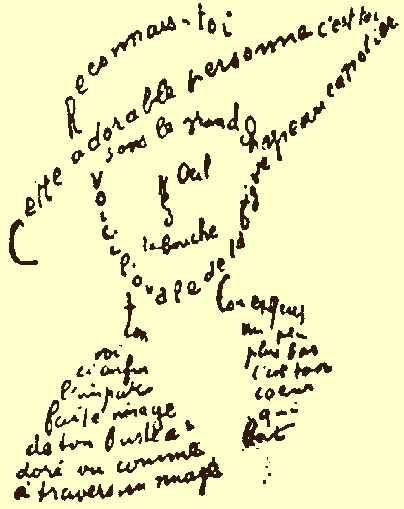Calligrams on:
[Wikipedia]
[Google]
[Amazon]
 A calligram is text arranged in such a way that it forms a thematically related image. It can be a poem, a phrase, a portion of
A calligram is text arranged in such a way that it forms a thematically related image. It can be a poem, a phrase, a portion of
File:Shiite Calligraphy symbolising Ali as Tiger of God.svg, Calligram of a tiger in Arabic script
File:Ioane sineli, klemaqsi (snake).svg, Calligram of a snake in
 A calligram is text arranged in such a way that it forms a thematically related image. It can be a poem, a phrase, a portion of
A calligram is text arranged in such a way that it forms a thematically related image. It can be a poem, a phrase, a portion of scripture
Religious texts, including scripture, are texts which various religions consider to be of central importance to their religious tradition. They differ from literature by being a compilation or discussion of beliefs, mythologies, ritual pra ...
, or a single word; the visual arrangement can rely on certain use of the typeface
A typeface (or font family) is the design of lettering that can include variations in size, weight (e.g. bold), slope (e.g. italic), width (e.g. condensed), and so on. Each of these variations of the typeface is a font.
There are thousands o ...
, calligraphy or handwriting, for instance along non-parallel and curved text lines, or in shaped paragraphs. The image created by the words illustrates the text by expressing visually what it says, or something closely associated; it can also, on purpose, show something contradictory with the text or otherwise be misleading, or can contribute additional thoughts and meanings to the text.
Writers
Guillaume Apollinaire
Guillaume Apollinaire) of the Wąż coat of arms. (; 26 August 1880 – 9 November 1918) was a French poet, playwright, short story writer, novelist, and art critic of Polish descent.
Apollinaire is considered one of the foremost poets of t ...
was a famous calligram writer and author of a book of poems called ''Calligrammes
''Calligrammes: Poems of Peace and War 1913-1916'', is a collection of poems by Guillaume Apollinaire which was first published in 1918 (see 1918 in poetry). ''Calligrammes'' is noted for how the typeface and spatial arrangement of the words o ...
''.
José Juan Tablada
José Juan de Aguilar Acuña Tablada (April 3, 1871 – August 2, 1945) was a Mexican poet, art critic and, for a brief period, diplomat. A pioneer of oriental studies, and champion of Mexican art, he spent a good portion of his life living abro ...
wrote a book of Spanish-language calligrams entitled Li-Po y otros poemas''.''
Gallery
Georgian script
The Georgian scripts are the three writing systems used to write the Georgian language: Asomtavruli, Nuskhuri and Mkhedruli. Although the systems differ in appearance, their letters share the same names and alphabetical order and are writte ...
File:Guillaume Apollinaire Calligramme.JPG, Calligram about the Eiffel Tower by Guillaume Apollinaire
Guillaume Apollinaire) of the Wąż coat of arms. (; 26 August 1880 – 9 November 1918) was a French poet, playwright, short story writer, novelist, and art critic of Polish descent.
Apollinaire is considered one of the foremost poets of t ...
File:El Cal·ligrama més gran del món (26517405610).jpg, Biggest calligram in the world, part of the permanent exhibition of the Valencian Museum of Ethnology
The Valencian Museum of Ethnology (Museu Valencià d'Etnologia) is a museum located in the city of Valencia, mediterranean Spain. The museum mission defines it as cultural institution primarily devoted to collect, research and communicate the ...
.
File:Poire typo..JPG, In 1834 a French court ordered the satiric newspaper ''Le Charivari
''Le Charivari'' was an illustrated magazine published in Paris, France, from 1832 to 1937. It published caricatures, political cartoons and reviews. After 1835, when the government banned political caricature, ''Le Charivari'' began publishing ...
'' to publish on its front page a judgement entered against it for having carried a drawing of King Louis-Philippe
Louis Philippe (6 October 1773 – 26 August 1850) was King of the French from 1830 to 1848, and the penultimate monarch of France.
As Louis Philippe, Duke of Chartres, he distinguished himself commanding troops during the Revolutionary Wa ...
in the shape of a pear. The newspaper printed the document as instructed—but in the shape of a pear.
See also
*Ambigram
An ambigram is a calligraphic design that has several interpretations as written.
The term was coined by Douglas Hofstadter in 1983. Most often, ambigrams appear as visually symmetrical words. When flipped, they remain unchanged, or they mutate ...
*Concrete poetry
Concrete poetry is an arrangement of linguistic elements in which the typographical effect is more important in conveying meaning than verbal significance. It is sometimes referred to as visual poetry, a term that has now developed a distinct me ...
*Islamic calligraphy
Islamic calligraphy is the artistic practice of handwriting and calligraphy, in the languages which use Arabic alphabet or the alphabets derived from it. It includes Arabic, Persian, Ottoman, and Urdu calligraphy.Chapman, Caroline (2012). ...
*Micrography
Micrography (from Greek, literally small-writing – "Μικρογραφία"), also called microcalligraphy, is a Jewish form of calligrams developed in the 9th century, with parallels in Christianity and Islam,Visual poetry
Literary theorists have identified visual poetry as a development of concrete poetry but with the characteristics of intermedia in which non-representational language and visual elements predominate.
Differentiation from concrete poetry
As the l ...
References
* * (with many Japanese calligrams) * * Graphic poetry {{poetry-stub ru:Фигурные стихи